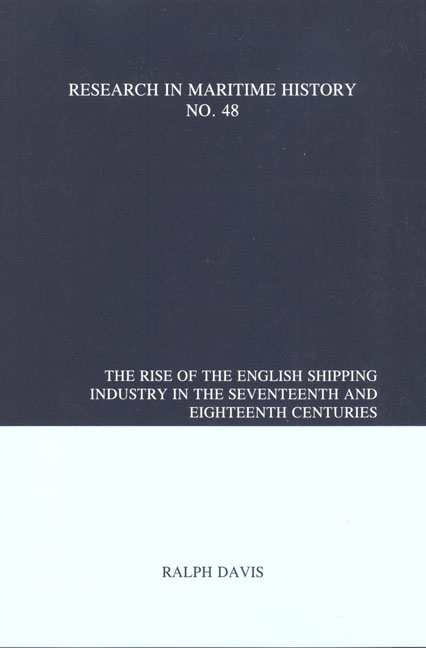Book contents
- Frontmatter
- Contents
- Introduction to the 2012 Edition
- Series Editor's Note
- Introduction
- Preface
- Chapter 1 The Widening of Horizons, 1560-1689
- Chapter 2 Consolidation, 1689-1775
- Chapter 3 Ships and Shipbuilders in the Seventeenth Century
- Chapter 4 Ships and Shipbuilders in the Eighteenth Century
- Chapter 5 The Shipowners
- Chapter 6 The Merchant Seamen
- Chapter 7 The Pay and Conditions of Merchant Seamen
- Chapter 8 Shipping Management and the Role of the Master
- Chapter 9 Shipping and Trade
- Chapter 10 The Nearby and Northern European Trades
- Chapter 11 The Southern European and Mediterranean Trades
- Chapter 12 The East Indian Trade
- Chapter 13 The American and West Indian Trades
- Chapter 14 The Government and the Shipping Industry
- Chapter 15 War and the Shipping Industry
- Chapter 16 Four Ships and Their Fortunes
- Chapter 17 Was It a Profitable Business?
- Chapter 18 Conclusion
- Appendix A A Note on the Shipping Statistics, 1686-1788
- Appendix B Sources for the History of the Shipping Industry
- Index
Chapter 3 - Ships and Shipbuilders in the Seventeenth Century
- Frontmatter
- Contents
- Introduction to the 2012 Edition
- Series Editor's Note
- Introduction
- Preface
- Chapter 1 The Widening of Horizons, 1560-1689
- Chapter 2 Consolidation, 1689-1775
- Chapter 3 Ships and Shipbuilders in the Seventeenth Century
- Chapter 4 Ships and Shipbuilders in the Eighteenth Century
- Chapter 5 The Shipowners
- Chapter 6 The Merchant Seamen
- Chapter 7 The Pay and Conditions of Merchant Seamen
- Chapter 8 Shipping Management and the Role of the Master
- Chapter 9 Shipping and Trade
- Chapter 10 The Nearby and Northern European Trades
- Chapter 11 The Southern European and Mediterranean Trades
- Chapter 12 The East Indian Trade
- Chapter 13 The American and West Indian Trades
- Chapter 14 The Government and the Shipping Industry
- Chapter 15 War and the Shipping Industry
- Chapter 16 Four Ships and Their Fortunes
- Chapter 17 Was It a Profitable Business?
- Chapter 18 Conclusion
- Appendix A A Note on the Shipping Statistics, 1686-1788
- Appendix B Sources for the History of the Shipping Industry
- Index
Summary
The sixteenth century saw great technical changes in the ships of Northern Europe; changes which have a well-documented history. Broadly speaking, they were of two kinds. First was the transition from the one-masted to the three-masted ship, giving scope for a variety of sails with particular functions; the merchant ship rig which was then developed consisted of spritsail, foresail and foretopsail, mainsail and main topsail, and a lateen mizzen. It was modified by a series of small steps over the next century. The second change, associated with the first, was the lengthening of the ship in relation to its beam; a change which might or might not (according to the ship's intended use) be accompanied by a refinement of the lines of bow and stern to give greater speed and manoeuvrability. The ship of 1450 rarely had a keel more than twice as long as the beam; in ships of 1600 a ratio of three to one was becoming common. The new masting and sail plan is found in quite small English ships at least as far back as the 1530s, but the full development from “round ship” to “long ship” is later, dating for warships from the 1570s; even as late as 1600 nearly half the royal ships had a proportion of keel length to beam of less than two and three-quarters.
This technical revolution was still working itself out at the time of the appearance - or rather reappearance - of the large merchant ship in English ownership. If the accounts of sixteenth-century commerce can be believed, Englishmen had almost abandoned the use of large ships in the middle of the century, when the strangling of direct English connections with the Mediterranean and the Baltic, and the quarrels with Spain, intensified the concentration of English trade on nearby Antwerp and the ports of France.
The large vessels that gradually wore out or were lost and not replaced were “round ships;” then, quite suddenly, in the last quarter of the century, when the “long ship” was being developed, the need for large ships was revived.
- Type
- Chapter
- Information
- Publisher: Liverpool University PressPrint publication year: 2012

